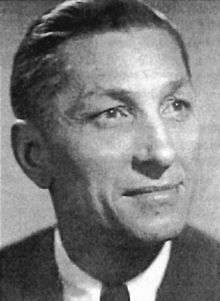Gheorghe Pintilie

Gheorghe Pintilie (born Pantelei Bodnarenko, also rendered as Pintilie Bodnarenco, and nicknamed Pantiuşa; 1902 – August 11, 1985) was a Soviet intelligence agent, Russian citizen and naturalised Romanian communist activist of Jewish origin,[1] and the first Director of the Securitate. As such, he was one of the main organizers of the repression in Communist Romania, responsible for the arrest, deportation, and internment of around 400,000 people.[2]
He was born in Tiraspol, Russian Empire (now in Transnistria, Moldova). As an adolescent, he fought with the Red Army in the Russian Civil War.[3] Subsequently, he was recruited by Soviet intelligence to carry out espionage and sabotage actions in Romania.[3] He was caught, and incarcerated at the Doftana and Caransebeş prisons, where he befriended Gheorghe Gheorghiu-Dej, who was to become the General Secretary of the Romanian Communist Party (PCR) in 1945.
After World War II, Pintilie married Ana Toma, a top aide to Ana Pauker. The couple adopted two children (Radu and Ioana).[3] Between 1945 and 1948, he was the chief of Gospodăria de partid, in control of all property of the PCR.[3]
In June, 1945, he led a squad that kidnapped Ştefan Foriş, the previous General Secretary of the PCR. A year later, after a confidential vote at the top of the party, Pintilie beat Foriş to death with a crowbar.
At the founding of the Securitate on August 30, 1948, Gheorghe Pintilie became the first Director of this organization (the positions of Deputy Directors went to Alexandru Nicolschi and Vladimir Mazuru). In this capacity, he was directly implicated in the Piteşti prison "experiment". The majority of deportations to the forced labor camps at the Danube-Black Sea Canal (referred to as the "graveyard of the Romanian bourgeoisie" by the Communist authorities) were approved by Pintilie and his deputies.[3][4]
Pintilie played a considerable role in the establishment of a communist terror apparatus in Romania. As Vladimir Tismăneanu argues, "if one does not grasp the role of political thugs such as the Soviet spies Pintilie Bondarenko (Pantiuşa) and Alexandru Nikolski in the exercise of terror in Romania during the most horrible Stalinist period, and their personal connections with Gheorghe Gheorghiu-Dej and members of his entourage, it is difficult to understand the origins and the role of the Securitate".[5]
He stayed as general director of the Securitate and as an adjunct minister in the Ministry of the Interior until his retirement in 1963. In 1968, he was excluded from the Communist Party; nevertheless, he was decorated in 1971 by Nicolae Ceauşescu with the "Tudor Vladimirescu" medal.[3]
Pintilie died in Bucharest in 1985. He was buried with full honors at the Ghencea Military Cemetery.[3]
References
- ↑ Ion Turcanu, "Istoria romanilor: Cu o privire mai larga asupra culturii". Istros. 2007. ISBN 9789731871028.
- ↑ Stejărel Olaru, "The communist regime and its legacy in Romania", Stiftung zur Aufarbeitung der SED-Diktatur, Berlin-Bucharest, July 2004
- 1 2 3 4 5 6 7 Vladimir Tismăneanu, "Cǎlǎii stalinişti - Cazul Pantiuşa", Cotidianul, 21 April 2006
- ↑ Ion Mihai Pacepa, "E timpul ca Securitatea să fie repudiată (IV)", in Jurnalul Naţional, October 8, 2005
- ↑ Stalinism for All Seasons: A Political History of Romanian Communism (University of California Press, Berkeley, 2003). ISBN 0-520-23747-1 p. 20
External links
- The Security Police (Securitate) between 1948 and 1989 at The Memorial of the Victims of Communism and of the Resistance
- (Romanian) "Politica si servicii secrete", interview of Viorel Patrichi with General (retired) Nicolae Pleșiță, Lumea
- (Romanian) Gabriel Catalan, Mircea Stănescu, Scurtă istorie a Securităţii ("Short history of the Securitate"), Sfera Politicii, Nr. 109 (2004), pp. 38–53.